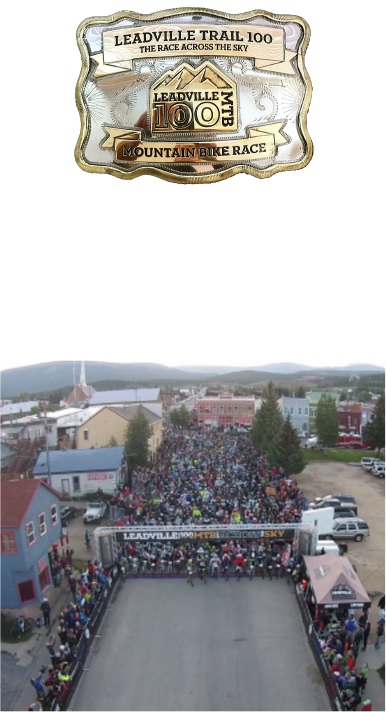
Building Life Time

Pressure can be your friend, if you know how to handle it.
When we built our first chain of health clubs, we learned a rival company was looking at some real estate in the same area we were interested in. They’d actually been invited by the real estate agents after we’d rejected a deal they’d offered us. We were a team that had competitive blood pumping through our veins, and it was this type of pressure that made us work harder to find a better site, overhaul it, build our club and get to market faster.
We didn’t panic or worry; we embraced the challenge, and
it became clear how certain kinds of stress are indeed beneficial.
We’re reminded that every time we exercise, we’re purposefully stressing muscles to make them grow bigger and stronger, however, worry is not a good exercise. It actually depletes our strength and uses emotional energy that prevents us from doing things that are helpful.
No type of anxiety ever solves problems.


I love to compete in hundred-mile mountain bike races. Designed to push the limits of human capability, they’re excruciating and there’s times your body is screaming at you to stop. Fear can set in…the question “how can I finish…” runs constantly through your head.
As these thoughts close in, I shift more than the gears on my bike.
I shift my thinking.
Instead of obsessing about all the miles ahead, I focus on the next checkpoint. I refuse to second-guess myself about being better prepared or dwell on pain or give in to distractions.
It’s also rare that anyone just shows up, gets on their bike and starts to pedal, hoping for the best. Every rider rigorously prepares months in advance with a training program that will prepare their body and their mind. Bikes are tuned, and the right food and hydration are thoughtfully planned. Personally, I prepare almost as much in my head for the trial ahead, reminding myself to take one turn, one summit at time.
This approach seems to work with a lot of “problems.” When things seem big and overwhelming, break it down. Attack one segment at a time. You don’t have to solve them all at once, just what’s in front of you.
Yet, no matter what, mistakes are inevitable.
Everyone makes them, but the beautiful thing is, missteps are an essential part of your own personal improvement. I actually expect the people I love to make mistakes, because they’re symbolic of growth, change, and movement. Acknowledging that you’re learning from them is crucial, and there’s no need for blame or even embarrassment.
Yet, we can’t forget to hold close the things we’ve done right. To remember and appreciate the things that have had a positive impact. The actions taken, the goals realized.

Case Study: Fitness

As I write this, I think about the fact that next year, I will be 60, and it seriously blows my mind. Once I get over that, however,
I remind myself how determined I am to stay active and fit as I hit this new horizon.
This is a good example, because it’s specific and measurable.
To say I want to stay active and healthy is not enough. I have to figure out what that looks like and how to make it happen day by day. For me, it means being able to engage in a wide range of sports and activities while staying engaged with my family, friends and the world.
To realize this, I have to find activities I enjoy and will do on a regular basis…and that I will continue to do as I get older. This all may seem obvious, but you’d be surprised how many people never move beyond a general decision to “exercise more” with no actionable plan or objective.
This means I do something physical every day. I take long rides down country roads with my daughter on beautiful Sunday mornings in July. I continue to compete in events, and I feel great joy as I race my son down sun-filled beaches.
The key is that you discover activity you love. Try something new, something that captures your imagination. Hiking, martial arts…ballroom dance. It can be seasonal, you can ski in the winter, ride your bike for the rest of the year. What will you love, that can continue through many a year?
Once you’ve found a physical activity that you enjoy – it will hopefully turn into a lifestyle.
If you’re bike riding, you may enter local bike races, or to go on an extended touring trip. If you’re swimming, you can play with number of laps or start meeting other swimmers at the club at the same time every morning.
Even if you’re doing it for enjoyment, you can set goals for yourself. Some of us are more competitive than others, but the same rules apply.
Goals are the specific components you need to achieve in order to reach your objective.
And some of life’s greatest moments come as you create a plan and work to achieve them.
If your objective is to make running a part of your routine and your goal is to run a 10K, you should build toward race day with a target distance for each day. Your plan may include learning warm-up exercises, finding a running partner, or figuring out what you need for your nutrition. Life Time’s running club has created so many friendships and relationships as people have come together to work on their goals. It’s almost easier when you share a schedule and train and track your progress together.
And again, while we know this is fun, it’s good to take these plans seriously. I can hear you saying, “Hey, BA, I just wanted to go running!” Believe me, I am not trying to put obstacles in your way, but most people benefit from very specific plans, for physical fitness or any other objective. Most people who are successful have some sort of plan even if they haven’t written it down.

This idea of goals and plans applies to both your personal and professional life.
We use the S.M.A.R.T. model at Life Time, which asks if our goals are
Over the years, as we’ve built Life Time clubs around the country, I’ve visited many constructions sites, and a well-crafted construction schedule is a work of art. Walking into the general contractor’s office and seeing a color-coded chart that captures the entire plan in a single glance is a joy for me to behold. It lists all the goals, the plans for achieving them and the order in which they must be accomplished, all driving toward the same objective – finishing the health club on schedule.
Each contractor and sub-contractor has their own plans and schedules, with each quantified, measurable goal another piece of the puzzle to be delivered on time. They know if they do not meet their individual goals, then the whole project can fall behind, costing thousands of dollars. We ALL take these plans very seriously.
The other advantage to making detailed plans is the satisfaction of progress. Things may evolve and change as you’re constantly learning more about your objectives – and yourself. You may discover your daily milestones are too modest or ambitious…or you might find a different approach works better for you. Even the large-scale construction schedules are constantly being tweaked and adjusted and you should be prepared to do the same.
Just like an airplane flying across the sky, our lives do not proceed in a straight line, but








